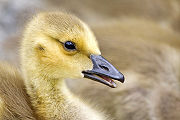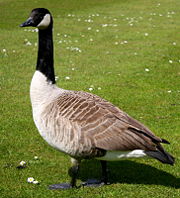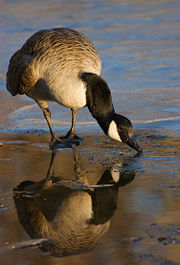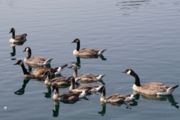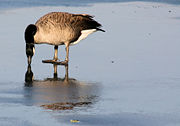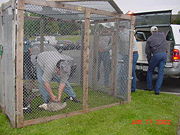Canada Goose
2008/9 Schools Wikipedia Selection. Related subjects: Birds
| Canada Goose | ||||||||||||||
|---|---|---|---|---|---|---|---|---|---|---|---|---|---|---|
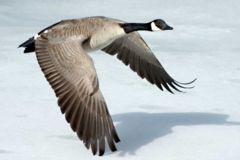 |
||||||||||||||
| Conservation status | ||||||||||||||
| Scientific classification | ||||||||||||||
|
||||||||||||||
| Binomial name | ||||||||||||||
| Branta canadensis (Linnaeus, 1758) |
||||||||||||||
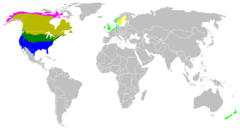 Canada Goose distribution, including native (dark tones) and introduced (light tones) populations
Canada Goose summer: yellow Canada Goose all year: green Canada Goose winter: blue Cackling Goose summer: pink |
||||||||||||||
| Subspecies | ||||||||||||||
|
The Canada Goose (Branta canadensis) is a goose belonging to the genus Branta native to North America. It is sometimes called 'Canadian Goose', although that is not considered to be strictly correct according to the American Ornithological Union and the Audubon Society. According to the Oxford English Dictionary, the first citation for Canada Goose dates back to 1772.
Taxonomy
The Canada Goose was one of the many species described by Linnaeus in his 18th-century work Systema Naturae. It belongs to the Branta genus of geese, which contains species with largely black plumage, distinguishing them from the grey species of the Anser genus. The specific epithet canadensis is a New Latin word meaning "of Canada".
Description
The black head and neck with white "chinstrap" distinguish the Canada Goose from all except the Barnacle Goose, but the latter has a black breast, and grey, rather than brownish, body plumage. There are seven subspecies of this bird, of varying sizes and plumage details, but all are recognizable as Canada Geese. Some of the smaller races can be hard to distinguish from the newly-separated Cackling Goose.
This species is 76-110 cm (30-43 in) long with a 127-180 cm (50-71 in) wingspan. The male usually weighs 3.2–6.5 kg, (7–14 pounds), and can be very aggressive in defending territory. The female looks virtually identical but is slightly lighter at 2.5–5.5 kg (5.5–12 pounds), generally 10% smaller than its male counterpart, and has a different honk. An exceptionally large male of the race B. c. maxima, the "giant Canada goose" (which rarely exceed 8 kg/18 lb), weighed 10.9 kg (24 pounds) and had a wingspan of 2.24 m (88 inches). The life span in the wild is 10–24 years.
Distribution and habitat
This species is native to North America. It breeds in Canada and the northern United States in a variety of habitats. Its nest is usually located in an elevated area near water, sometimes on a beaver lodge. Its eggs are laid in a shallow depression lined with plant material and down. The Great Lakes region maintains a very large population of Canada Geese.
By the early 20th century, over-hunting and loss of habitat in the late 1800s and early 1900s had resulted in a serious decline in the numbers of this bird in its native range. The Giant Canada Goose subspecies was believed to be extinct in the 1950s until, in 1962, a small flock was discovered wintering in Rochester, Minnesota by Harold Hanson of the Illinois Natural History Survey. With improved game laws and habitat recreation and preservation programs, their populations have recovered in most of their range, although some local populations, especially of the subspecies occidentalis, may still be declining.
In recent years, Canada Geese populations in some areas have grown substantially, so much so that many consider them pests (for their droppings, the bacteria in their droppings, noise and confrontational behaviour). This problem is partially due to the removal of natural predators and an abundance of safe, man-made bodies of water (such as on golf courses, public parks and beaches, and in planned communities).
Contrary to its normal migration routine, large flocks of Canada Geese have established permanent residence in the Chesapeake Bay and in Virginia's James River regions.
Outside North America
Canada Geese have reached northern Europe naturally, as has been proved by ringing recoveries. The birds are of at least the subspecies parvipes, and possibly others. Canada Geese are also found naturally on the Kamchatka Peninsula in eastern Siberia, eastern China, and throughout Japan.
Greater Canada Geese have also been introduced in Europe, and have established populations in Great Britain, the Netherlands, Belgium, and Scandinavia. Semi-tame feral birds are common in parks, and have become a pest in some areas. The geese were first introduced in Britain in the late 17th century as an addition to King James II's waterfowl collection in St. James's Park.
Canada Geese were introduced as a game bird into New Zealand and have also become a problem in some areas.
Behaviour
Like most geese, the Canada Goose is naturally migratory with the wintering range being most of the United States. The calls overhead from large groups of Canada Geese flying in V-shaped formation signal the transitions into spring and autumn. In some areas, migration routes have changed due to changes in habitat and food sources. In mild climates, such as the Pacific Northwest, due to a lack of former predators, some of the population has become non-migratory.
Diet
The diet of the Canada Goose includes green vegetation and grains. The Canada Goose eats a variety of grasses when on land. It feeds by grasping a blade of grass with the bill, then tearing it with a jerk of the head. The Canada Goose also eats grains such as wheat, beans, rice, and corn when they are available. In the water, it feeds from silt at the bottom of the body of water. It also feeds on aquatic plants, such as seaweeds.
Reproduction
During the second year of their lives, Canada Geese find a mate. They are monogamous, and most couples stay together all of their lives. If one is killed, the other may find a new mate. The female lays 4–8 eggs and both parents protect the nest while the eggs incubate, but the female spends more time at the nest than the male. Known egg predators include Arctic Foxes, Red Foxes, all large gulls, Common Raven, American Crows and bears. During this incubation period, the adults lose their flight feathers, so they cannot fly until after their eggs hatch. This stage lasts for 25–28 days.
Adult geese are often seen leading their goslings in a line, usually with one parent at the front, and the other at the back. While protecting their goslings, parents often violently chase away nearby creatures, from small blackbirds to other geese, to humans that approach, after warning them by giving off a hissing sound. Most of the species that prey on eggs will also take a gosling. However, geese may form groups of a number of goslings and a few adults, called crèches. The offspring enter the fledging stage any time from 6 to 9 weeks of age. They do not leave their parents until after the spring migration, when they return to their birthplace. Once they reach adulthood, Canada Geese are rarely preyed on, but can be taken by Coyotes, Red Foxes, Gray Wolves, Snowy Owls, Great Horned Owls, Golden Eagles and, most often, Bald Eagles. Canada Goose populations inhabiting areas also inhabited by domesticated geese can and will interbreed with them, producing offspring that often resemble Canada Geese in shape, but with a white or gray body, dark grey head and neck, and off-white chin, with pink feet.
Systematics
The Cackling Goose was originally considered to be the same species or a subspecies of the Canada Goose, but in July 2004 the American Ornithologists' Union's Committee on Classification and Nomenclature split the two into two species, making Cackling Goose into a full species with the scientific name Branta hutchinsii. The British Ornithologists Union followed suit in June 2005.
The AOU has divided the many subspecies between the two animals. To the present species were assigned:
- Atlantic Canada Goose, Branta canadensis canadensis
- Interior Canada Goose, Branta canadensis interior
- Giant Canada Goose, Branta canadensis maxima
- Moffitt's Canada Goose, Branta canadensis moffitti
- Vancouver Canada Goose, Branta canadensis fulva
- Dusky Canada Goose, Branta canadensis occidentalis
- part of "Lesser complex", Branta canadensis parvipes
The distinctions between the two geese have led to confusion and debate among ornithologists. This has been aggravated by the overlap between the small types of Canada Goose and larger types of Cackling Goose. The old "Lesser Canada Goose" was believed to be a partly hybrid population, with the birds named taverneri considered a mixture of minima, occidentalis and parvipes. In addition, it has been determined that the Barnacle Goose is a derivative of the Cackling Goose lineage, whereas the Hawaiian Goose is an insular representative of the Canada Goose.
Relationship with humans
In North America, non-migratory Canada Goose populations have been on the rise. The species is frequently found on golf courses, parking lots and urban parks, which would have previously hosted only migratory geese on rare occasions. Owing to its adaptability to human-altered areas, it has become the most common waterfowl species in North America. In many areas, non-migratory Canada Geese are now regarded as pests. They are suspected of being a cause of an increase in high fecal coliforms at beaches. An extended hunting season and the use of noise makers have been used in an attempt to disrupt suspect flocks.
Since 1999, The USDA Wildlife Services agency has been engaged in lethal culls of Canada Geese primarily in urban or densely populated areas. The agency responds to municipalities or private land owners, such as golf courses, who find the geese obtrusive or object to their waste.
In 1995, a US Air Force E-3 Sentry aircraft at Elmendorf AFB, Alaska struck a flock of Canada Geese on takeoff and crashed, killing all 24 crew. The accident sparked efforts to avoid such events, including habitat modification, scare tactics, herding and relocation, and culling of flocks.
When threatened, geese stand erect and hiss.
